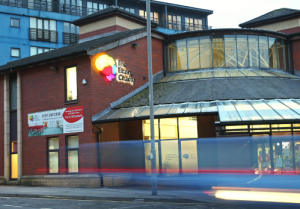
SPOTLIGHT ON: A history of disabled access – the movement to make Britain’s buildings more accessible and disability-friendly
Selwyn Goldsmith was a pioneer in overcoming architectural disability
Around 300,000 people became disabled in Britain as a direct result of the Second World War. In a landscape of Victorian and Edwardian architecture, access needs were changing fast.
Mobility and accessibility provided challenges for most towns and cities, as most buildings offered countless steps and staircases to climb.
The limiting urban environment made it even more difficult for disabled people to obtain employment, access public transport or even go to the theatre.
One of the most prevalent childhood illnesses of the time was polio, for which there was no vaccine until the mid-1950s.
Selwyn Goldsmith’s plans for creating accessible buildings and unisex public toilets – not just for wheelchair users
One polio survivor was enterprising young architect Selwyn Goldsmith, who set out a plan to overcome ‘architectural disability’.

Citing the ‘institutional discrimination’ of the UK’s old-fashioned buildings, Goldsmith focused on providing access for not only people in wheelchairs, but for those with other conditions which made navigating buildings a challenge too.
His book ‘Designing for the Disabled’, first published in 1963, became a bible for architects and the planning departments of local authorities.
Goldsmith’s mantra was for people with disabilities to be able to access and use buildings in the same ways as others and integrated rather than segregated.
The following year, he told Norwich as a location to pilot his study. He interviewed 284 local disabled people and found their key priority was public toilets – followed by shops, restaurants and churches.
Goldsmith’s solution was to create a disabled access unisex toilet for the residents of Norwich; the first of its kind in England.
He was also instrumental in the arrival of 15 ramped kerbs scattered across the city, which were rapidly adopted as standard both nationally and internationally.
A national campaign for disability rights and accessibility for people with disabilities
While these innovations in disabled access were welcomed, progress was slow, with government and councils proving difficult to hurry into action.
In September 1972, a letter appeared in The Guardian from Paul Hunt, a disability campaigner.
He was intent on rallying disabled people around Britain to lobby on issues such as accessibility, employability and education.
His letter helped establish the Union of the Physically Impaired Against Segregation (UPIAS), which campaigned politically on the issues surrounding being disabled.
Hunt and co-founder Vic Finkelstein’s disability rights cause went on to inspire a similar movement in the States a decade later.
The Society for Disability Studies was launched and led by the author and activist Irving Zola.
Meanwhile, UPIAS continued its campaigning work in the UK to permit disabled people to gain independence in all areas of life.
One of its pioneering projects was Grove Road Housing in Sutton-in-Ashfield, Nottinghamshire. The housing scheme was Britain’s first integrated co-operative housing development, bringing together disabled and non-disabled residents to live side by side.
The introduction of the Disability Discrimination Act
Traction from campaigning pressure groups lobbying Parliament resulted in the creation of the Disability Discrimination Act in 1995.
This put in new measures to ensure that all public buildings were accessible and had suitable facilities.

Beyond accessibility: the concept of modern universal design
In the 21st century, views shifted.
Instead of adapting buildings with special facilities, it was instead suggested that ‘universal design’ would allow anyone with a disability to access any part of the building.
There had been a few nods to the concept in the 1970s, but the idea took flight in the early Noughties.
Venues, schools and World Heritage sites like the Tower of London fully embraced Goldsmith’s vision of an architecturally enabling world.
Disabled access in the UK today, and what still needs to change for people with disabilities
The journey to bring full accessibility continues. The Accessible Guide was founded in Liverpool by disabled people to provide up to date access information on venues and businesses across the region.
In its 2018 survey, The Accessible Guide asked ‘mystery shoppers’ to survey a wide range of destinations, from music venues and restaurants to cathedrals and bars.
The results showed while two thirds were step-free, less than half had all three key aspects of physical access – a step-free entrance, step-free routes to all areas of the venue, and at least one functioning accessible toilet.
Around half the venues were not fully accessible to wheelchair users and those with limited mobility.
There is still much to do to modernise many venue spaces in the UK, but the work of the architectural pioneers of the 20th Century still lives on.
This is proven by the fact that Selwyn Goldsmith’s ‘Designing for the Disabled’ is still in print and continues to influence the architects of today.
The Brain Charity’s SPOTLIGHT ON series highlights the work being carried out to raise awareness of different conditions by charities, groups and individuals. To submit an article, please email us.
Category: Spotlight on series
Published: 10 October 2022













